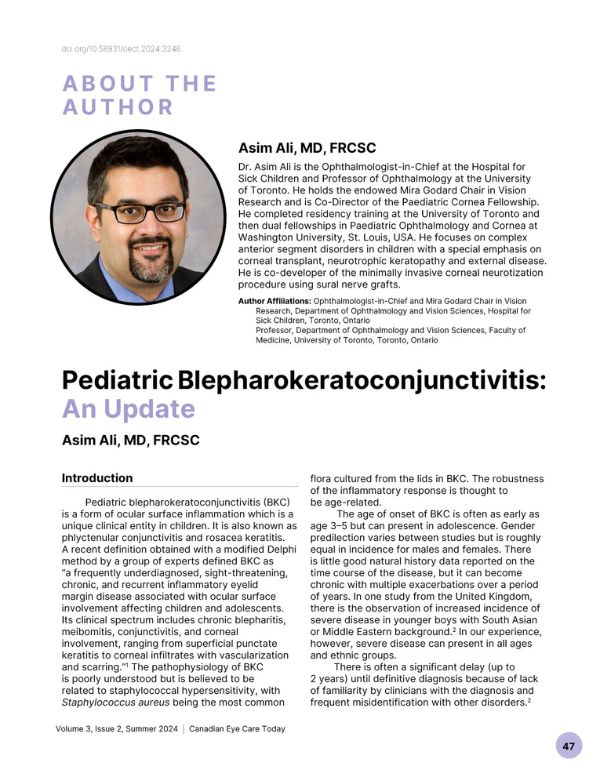Pediatric Blepharokeratoconjunctivitis: An Update
DOI:
https://doi.org/10.58931/cect.2024.3246Abstract
Pediatric blepharokeratoconjunctivitis (BKC) is a form of ocular surface inflammation which is a unique clinical entity in children. It is also known as phlyctenular conjunctivitis and rosacea keratitis. A recent definition obtained with a modified Delphi method by a group of experts defined BKC as “a frequently underdiagnosed, sight‑threatening, chronic, and recurrent inflammatory eyelid margin disease associated with ocular surface involvement affecting children and adolescents. Its clinical spectrum includes chronic blepharitis, meibomitis, conjunctivitis, and corneal involvement, ranging from superficial punctate keratitis to corneal infiltrates with vascularization and scarring.” The pathophysiology of BKC is poorly understood but is believed to be related to staphylococcal hypersensitivity, with Staphylococcus aureus being the most common flora cultured from the lids in BKC. The robustness of the inflammatory response is thought to be age‑related.
The age of onset of BKC is often as early as age 3–5 but can present in adolescence. Gender predilection varies between studies but is roughly equal in incidence for males and females. There is little good natural history data reported on the time course of the disease, but it can become chronic with multiple exacerbations over a period of years. In one study from the United Kingdom, there is the observation of increased incidence of severe disease in younger boys with South Asian or Middle Eastern background.2 In our experience, however, severe disease can present in all ages and ethnic groups.
References
Nallely R, Morales-Mancillas NR, Velazquez-Valenzuela F, et al. Pediatric blepharokeratoconjunctivitis: A consensus for its definition and diagnostic classification criteria. The Pediatric Blepharokeratoconjunctivitis Study Group. JAMA Ophthalmology. Jan 2024; 142(1):39-47. DOI: https://doi.org/10.1001/jamaophthalmol.2023.5750
Viswalingam M, Rauz S, Morlet N, et al. Blepharokeratoconjunctivitis in children: diagnosis and treatment. Br J Ophthalmol. 2005;89(4):400-3. DOI: https://doi.org/10.1136/bjo.2004.052134
Hamada S, Khan I, Denniston AK, et al. Childhood blepharokeratoconjunctivitis: characterising a severe phenotype in white adolescents. Br J Ophthalmol. 2012;96(7):949-55. DOI: https://doi.org/10.1136/bjophthalmol-2011-300771
Choi DS, Djalilian A. Oral azithromycin combined with topical anti-inflammatory agents in the treatment of blepharokeratoconjunctivitis in children. J AAPOS. 2013;17(1):112-3. DOI: https://doi.org/10.1016/j.jaapos.2012.10.015
Doan S, Gabison EE, Nghiem-Buffet S, et al. Long-term visual outcome of childhood blepharokeratoconjunctivitis. Am J Ophthalmol. 2007;143(3):528-9. DOI: https://doi.org/10.1016/j.ajo.2006.09.058
Moon J, Lee J, Kim MK, et al. Clinical characteristics and therapeutic outcomes of pediatric blepharokeratoconjunctivitis. Cornea. 2023;42(5):578-83. DOI: https://doi.org/10.1097/ICO.0000000000003120

Downloads
Published
How to Cite
Issue
Section
License
Copyright (c) 2024 Canadian Eye Care Today

This work is licensed under a Creative Commons Attribution-NonCommercial-NoDerivatives 4.0 International License.
